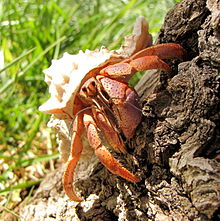Coenobita
| Coenobita | |
|---|---|
 |
|
| Caribbean hermit crab, C. clypeatus | |
| Scientific classification | |
| Kingdom: | Animalia |
| Phylum: | Arthropoda |
| Subphylum: | Crustacea |
| Class: | Malacostraca |
| Order: | Decapoda |
| Superfamily: | Paguroidea |
| Family: | Coenobitidae |
| Genus: |
Coenobita Latreille, 1829 |
| Type species | |
|
Pagurus clypeatus Fabricius, 1787 |
|
The genus Coenobita contains the sixteen species of terrestrial hermit crabs.
Coenobita species carry water in the gastropod shells they inhabit, allowing them to stay out of water for a long time.
The majority of the species are found in the Indo-Pacific region, with only one species in West Africa, one species occurring along the western Atlantic Ocean, and one species occurring on the Pacific coast of the Americas.
Coenobita is closely related to the coconut crab, Birgus latro, with the two genera making up the whole of the family Coenobitidae. The name Coenobita was coined by Pierre André Latreille in 1829, from an Ecclesiastical Latin word, ultimately from the Greek κοινόβιον, meaning "commune"; despite ending in a vowel, the genus is masculine in gender.
...
Wikipedia
